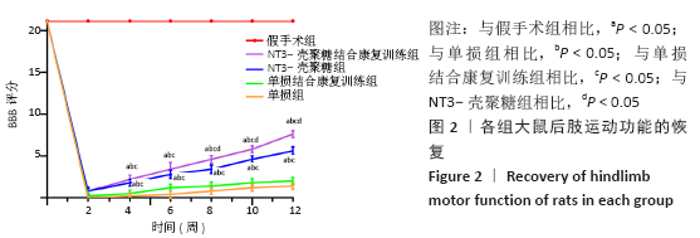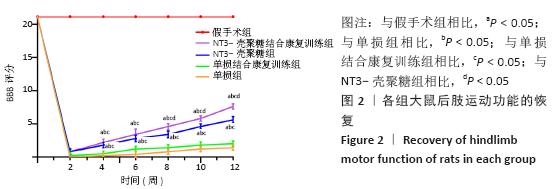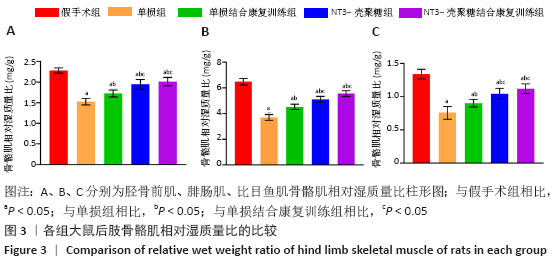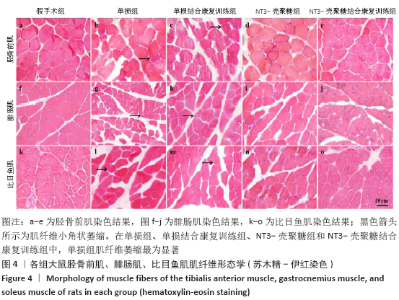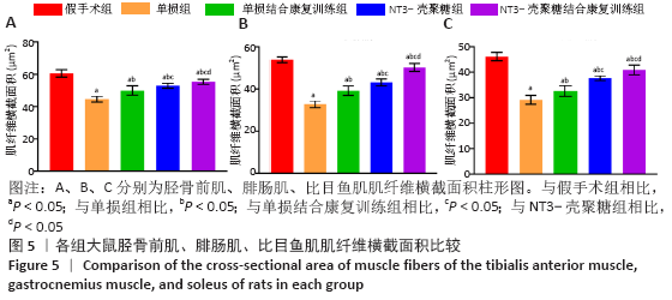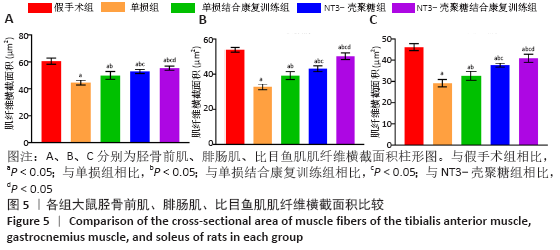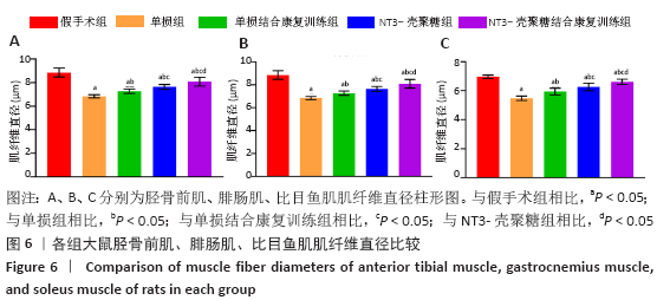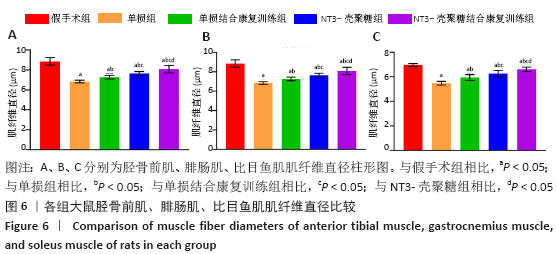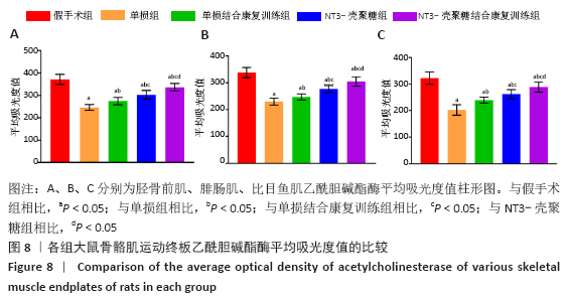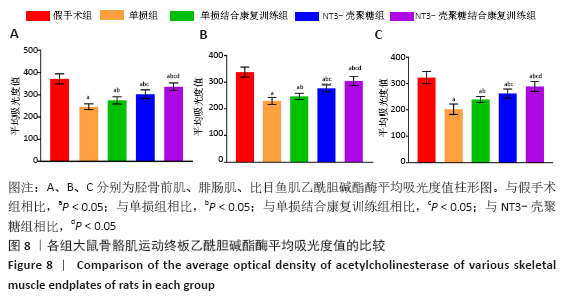Chinese Journal of Tissue Engineering Research ›› 2021, Vol. 25 ›› Issue (16): 2514-2520.doi: 10.3969/j.issn.2095-4344.3116
Previous Articles Next Articles
Rehabilitation training combined with neurotrophin 3-chitosan scaffolds enhanced skeletal muscle morphology and functional recovery in rats with spinal cord injury
Chen Xingying1, Hao Fei2, 3, Gao Yudan1, Zhao Wen1, Duan Hongmei1, Yang Chaoyang1, Li Xiaoguang1, 2, 3#br#
- 1Department of Neurobiology, Capital Medical University, Beijing 100069, China; 2Beijing Key Laboratory of Biomaterials and Nerve Regeneration, School of Biological Science and Medical Engineering, Beihang University, Beijing 100083, China; 3Biomedical Engineering Innovation Center, Medical Industry Cross Innovation Research Institute, Beihang University, Beijing 100083, China
-
Received:2020-03-17Revised:2020-03-28Accepted:2020-06-03Online:2021-06-08Published:2021-01-07 -
Contact:Li Xiaoguang, MD, Professor, Department of Neurobiology, Capital Medical University, Beijing 100069, China; Beijing Key Laboratory of Biomaterials and Nerve Regeneration, School of Biological Science and Medical Engineering, Beihang University, Beijing 100083, China; Biomedical Engineering Innovation Center, Medical Industry Cross Innovation Research Institute, Beihang University, Beijing 100083, China -
About author:Chen Xingying, Master candidate, Department of Neurobiology, Capital Medical University, Beijing 100069, China -
Supported by:the National Natural Science Foundation of China, No. 81941011, 31730030, 31650001, 31320103903 (to LXG); the National Key Research and Development Program, No. 2017YFC1104002, 2017YFC1104001 (to LXG); the National Natural Science Foundation of China, No. 31670988, 31971279 (to YCY); the Beijing Science and Technology Plan, No. Z181100001818007 (to YCY); the Key Project of Pcience and Technology Plan of Beijing Municipal Education Commission in 2018, No. KZ201810025030 (to YCY); the National Natural Science Foundation of China, No. 31771053 (to DHM); the General Program of China Postdoctoral Science Foundation, No. 230210465 (to HF)
CLC Number:
Cite this article
Chen Xingying, Hao Fei, Gao Yudan, Zhao Wen, Duan Hongmei, Yang Chaoyang, Li Xiaoguang. Rehabilitation training combined with neurotrophin 3-chitosan scaffolds enhanced skeletal muscle morphology and functional recovery in rats with spinal cord injury[J]. Chinese Journal of Tissue Engineering Research, 2021, 25(16): 2514-2520.
share this article
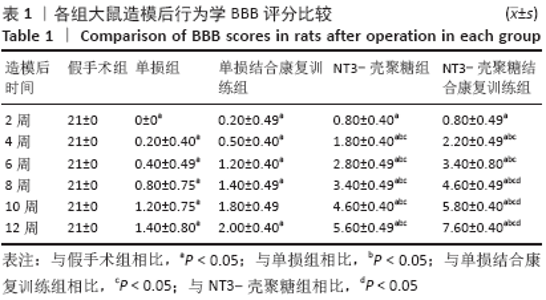
2.1 造模情况 单损组由于麻醉意外致死1只,NT3-壳聚糖组由于造模过程中硬脊膜撕毁1只,均给予补全。 2.2 各组大鼠行为学BBB评分 造模前各组大鼠BBB评分均为21分。造模后2周,单损组大鼠BBB评分均为0分,说明模型建立成功。造模后4周开始,NT3-壳聚糖组BBB评分高于单损组(P < 0.05),与前期研究结果一致;NT3-壳聚糖结合康复训练组从造模后4周开始BBB评分高于单损组(P < 0.05),造模后8周开始评分高于NT3-壳聚糖组(P < 0.05),说明康复训练进一步提高了NT3-壳聚糖诱导的完全性脊髓损伤大鼠后肢运动功能恢复;单损结合康复训练组各时间点BBB评分与单损组相比差异无显著性意义(P > 0.05),说明康复训练本身不能促进完全性脊髓损伤大鼠后肢运动功能的有限恢复。各组评分见表1,图2。 "
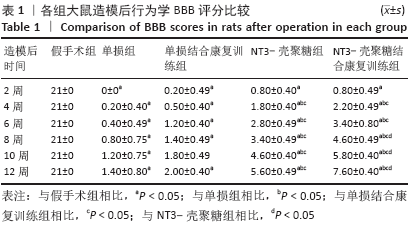
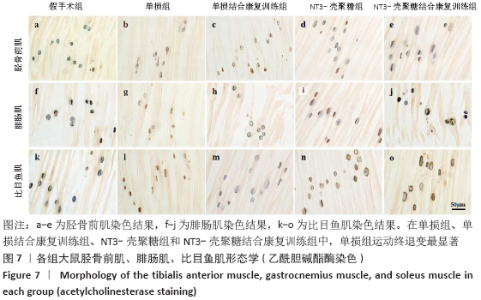
2.4 各组大鼠骨骼肌运动终板乙酰胆碱酯酶平均吸光度值比较 神经肌肉接头或称运动终板,是运动神经元轴突末梢在骨骼肌肌纤维上的接触点,是一种特化的化学突触,其递质是乙酰胆碱。乙酰胆碱酯酶是生物神经传导中的一种关键性酶,在胆碱能突触间,该酶能降解乙酰胆碱酯酶,终止神经递质对突触后膜的兴奋作用,保证神经信号在生物体内的正常传递。乙酰胆碱酯酶活性不仅可反映运动神经元的功能状态,而且终板区乙酰胆碱酯酶对于神经肌肉接头突触功能和结构的维持也是必需的,所以终板区乙酰胆碱酯酶含量的多少能够反映出运动神经元的功能状态和神经肌肉接头退变和再生情况[17-20]。 乙酰胆碱酯酶染色结果显示,除假手术组外,其他4组大鼠运动终板均出现显著退变,其中单损组最为显著,染色变淡,空泡明显,形态萎缩,部分运动终板出现崩解变性,只有残迹可见,见图7。 "
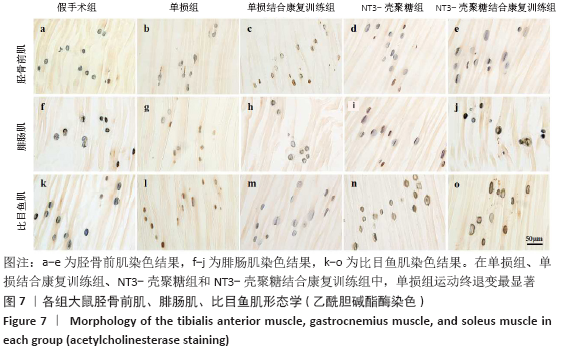
| [1] JI WC, JIANG WT, LI M, et al. miR-21 deficiency contributes to the impaired protective effects of obese rat mesenchymal stem cell-derived exosomes against spinal cord injury. Biochimie. 2019;167(6):171-178. [2] AHUJA CS, WILSON JR, NORI S, et al. Traumatic spinal cord injury. Nat Rev Dis Primers. 2017;3(14):170-180. [3] 杨俊松,郝定均,刘团江,等.急性脊髓损伤的临床治疗进展[J].中国脊柱脊髓杂志,2018,28(4):368-373. [4] ANWAR MA, AL STS, EID AH, et al. Inflammogenesis of Secondary Spinal Cord Injury. Front Cell Neurosci. 2016;9(10):98-102. [5] GORGEY AS, KHALIL RE, LESTER RM, et al. Paradigms of Lower Extremity Electrical Stimulation Training After Spinal Cord Injury. J Vis Exp. 2018; 8(132):1076-1082. [6] LUNDELL LS, SAVIKJ M, KOSTOVSKI E, et al. Protein translation,proteolysis and autophagy in human skeletal muscle atrophy after spinal cord injury. Acta Physiol (Oxf). 2018;16(7):192-202. [7] MAO Y, TONKIN RS, NGUYEN T, et al. Systemic Administration of Connexin43 Mimetic Peptide Improves Functional Recovery after Traumatic Spinal Cord Injury in Adult Rats. J Neurotrauma. 2017;34(3):707-719. [8] YANG Z, ZHANG A, DUAN H, et al. NT 3-chitosan elicits robust endogenous neurogenesis to enable functional recovery after spinal cord injury. Proc Natl Acad Sci U S A. 2015;112(43):13354-13359. [9] RAO JS, ZHAO C, HANG A, et al. NT 3-chitosan enables de novo regeneration and functional recovery in monkeys after spinal cord injury. Proc Natl Acad Sci U S A. 2018;115(24):E5595-E5604. [10] DUAN H, GE W, ZHANG A, et al. Transcriptome analyses reveal molecular mechanisms underlying functional recovery after spinal cord injury. Proc Natl Acad Sci U S A. 2015;112(43):13360-13365. [11] WANG Y, WU W, WU X, et al. Remodeling of lumbar motor circuitry remote to a thoracic spinal cord injury promotes locomotor recovery. Elife. 2018;7:e39016. [12] YUAN S, SHI Z, CAO F, et al. Epidemiological Features of Spinal Cord Injury in China: A Systematic Review. Front Neurol. 2018;9:683. [13] PATEL NP, HUANG JH. Hyperbaric oxygen therapy of spinal cord injury. Med Gas Res. 2017;7(2):133-143. [14] MARTINEZ M,ROSSIGNOL S.A dual spinal cord lesion paradigm to study spinal locomotor plasticity in the cat. Ann N Y Acad Sci. 2013;1279(4):127-134. [15] YOZBATIRAN N, KESER Z, DAVIS M, et al. Transcranial direct current stimulation (tDCS) of the primary motor cortex and robot-assisted arm training in chronic incomplete cervical spinal cord injury: A proof of concept sham-randomized clinical study. NeuroRehabilitation. 2016;39(3):401-411. [16] KELLER AV, WAINWRIGHT G, SHUM-SIU A, et al. Disruption of Locomotion in Response to Hindlimb Muscle Stretch at Acute and Chronic Time Points after a Spinal Cord Injury in Rats. J Neurotrauma. 2017;34(3):661-670. [17] BATTISTUZZO CR, RANK MM, FLYNN JR, et al. Effects Of treadmill training on hindlimb muscles of spinal cord injured mice. Muscle Nerve. 2017; 55(2):232-242. [18] TINTIGNAC LA, BRENNER HR, RUEGG MA, et al. Mechanisms regulating neuromus- cular junction development and function and causes of muscle wasting. Physiol Rev. 2015;95(3):809-852. [19] LIU W, CHAKKALAKAL JV. The composition,development and regeneration of neuromuscular junctions. Curr Top Dey Biol. 2018;126(2):99-124. [20] LARSSON L, DEGENS H, LI M, et al. Sarcopenia: Aging-Related Loss of Muscle Mass and Function. Physiol Rev. 2019;99(1):427-511. [21] DKS L, SCHOELLER SD, NDS K, et al. Protocol for a scoping review of skin self-care of people with spinal cord injury. BMJ Open. 2017;7(9):e017860. [22] BOYCE VS, MENDELL LM. Neurotrophic factors in spinal cord injury. Handb Exp Pharmacol. 2014;220(6):443-460. [23] 范晓华,纪树荣,周红俊,等.减重平板步行训练对完全性脊髓损伤患者下肢骨骼肌萎缩与步行能力的影响[J].中国康复理论与实践,2008, 14(1):50-52. [24] SOBOTKA S, CHEN J, NYIRENDA T, et al. Outcomes of muscle reinnervation with direct nerve implantation into the native motor zone of the target muscle. J Reconstr Microsurg. 2017;33(2):77-86. [25] RUDOLF R, DESCHENES MR, SANDRI M,et al. Neuromuscular junction degeneration in muscle wasting. Curr Opin Clin Nutr Metab Care. 2016; 19(3):177-181. [26] WILSON RJ, DRAKE J C, CUI D, et al. Mitochondrial protein Snitrosation protects against ischaemia reperfusion-induced denervation at neuromuscular junction in skeletal muscle. Free Radic Biol Med. 2018; 117(9):180-190. [27] MANTHOU M, ABDULLA DS, PAVLOV SP, et al. Whole body vibration (WBV) follo-wing spinal cord injury (SCI) in rats:Timing of intervention. Restor Neurol Neurosci. 2017;35(2):185-216. [28] 赵博伦.不同起始时间点机器人辅助减重步行训练对脊髓损伤康复作用的研究[D].吉林:吉林大学护理学院,2018. [29] KELLER AV, WAINWRIGHT G, SHUM-SIU A, et al. Disruption of Locomotion in Response to Hindlimb Muscle Stretch at Acute and Chronic Time Points after a Spinal Cord Injury in Rats. J Neurotrauma. 2017;34(3):661-670. [30] TOSOLINI AP, MOHANR, MORRIS R. Targeting the full length of the motrend plate regions in the mouse forelimb increases the uptake of Fluoro-Gold into corresponding spinal cord motoneurons. Front Neurol. 2013;4(58):1-10. [31] NEES TA, TAPPE-THEODOR A, SLIWINSKI C, et al. Early-onset treadmill training reduces mechanical allodynia and modulates calcitonin gene-te- lated peptide fiber density in lamina ll /N in a mouse model of spinal cord contusion injury. Pain. 2016;157(3):687-697. [32] STUART DG, HULYBORN H. Thomas graham brown (1882-1965),anders lundbery (1920),and the neural control of stepping. Brain Res Rev. 2008; 59(1):74-95. [33] KIM MK, LEE SA. Underwater treadmill training and gait ability in the normal adult. J Phys Ther Sci. 2017;29(1):67-69. [34] HACHEM LD, AHUJA CS, FEHLINGS MG, et al. Assessment and management of acute spinal cord injury: From point of injury to rehabilitation. J Spinal Cord Med. 2017;40(6):665-675. [35] FEHLINGS MG, WILSON JR, HARROP JS, et al. Efficacy and Safety of Methyl- prednisolone Sodium Succinate in Acute Spinal Cord Injury: A Systematic Review. Global Spine J. 2017;7(3):116S-137S. [36] WU Q, CAO Y, DONG C, et al. Neuromuscular interaction is required for neurotrophins mediated locomotor recovery following treadmill training in rat spinal cord injury. Peer J. 2016;4(2):e2025. |
| [1] | Min Youjiang, Yao Haihua, Sun Jie, Zhou Xuan, Yu Hang, Sun Qianpu, Hong Ensi. Effect of “three-tong acupuncture” on brain function of patients with spinal cord injury based on magnetic resonance technology [J]. Chinese Journal of Tissue Engineering Research, 2021, 25(在线): 1-8. |
| [2] | Jiang Hongying, Zhu Liang, Yu Xi, Huang Jing, Xiang Xiaona, Lan Zhengyan, He Hongchen. Effect of platelet-rich plasma on pressure ulcers after spinal cord injury [J]. Chinese Journal of Tissue Engineering Research, 2021, 25(8): 1149-1153. |
| [3] | Wan Ran, Shi Xu, Liu Jingsong, Wang Yansong. Research progress in the treatment of spinal cord injury with mesenchymal stem cell secretome [J]. Chinese Journal of Tissue Engineering Research, 2021, 25(7): 1088-1095. |
| [4] | Kong Desheng, He Jingjing, Feng Baofeng, Guo Ruiyun, Asiamah Ernest Amponsah, Lü Fei, Zhang Shuhan, Zhang Xiaolin, Ma Jun, Cui Huixian. Efficacy of mesenchymal stem cells in the spinal cord injury of large animal models: a meta-analysis [J]. Chinese Journal of Tissue Engineering Research, 2021, 25(7): 1142-1148. |
| [5] | Li Cai, Zhao Ting, Tan Ge, Zheng Yulin, Zhang Ruonan, Wu Yan, Tang Junming. Platelet-derived growth factor-BB promotes proliferation, differentiation and migration of skeletal muscle myoblast [J]. Chinese Journal of Tissue Engineering Research, 2021, 25(7): 1050-1055. |
| [6] | He Xiangzhong, Chen Haiyun, Liu Jun, Lü Yang, Pan Jianke, Yang Wenbin, He Jingwen, Huang Junhan. Platelet-rich plasma combined with microfracture versus microfracture in the treatment of knee cartilage lesions: a meta-analysis [J]. Chinese Journal of Tissue Engineering Research, 2021, 25(6): 964-969. |
| [7] | Ma Binxiang, He Wanqing, Zhou Guangchao, Guan Yonglin. Triptolide improves motor dysfunction in rats following spinal cord injury [J]. Chinese Journal of Tissue Engineering Research, 2021, 25(5): 701-706. |
| [8] | Zhang Bin, Sun Lihua, Zhang Junhua, Liu Yusan, Cui Caiyun. A modified flap immediate implant is beneficial to soft tissue reconstruction in maxillary aesthetic area [J]. Chinese Journal of Tissue Engineering Research, 2021, 25(5): 707-712. |
| [9] | Chen Junyi, Wang Ning, Peng Chengfei, Zhu Lunjing, Duan Jiangtao, Wang Ye, Bei Chaoyong. Decalcified bone matrix and lentivirus-mediated silencing of P75 neurotrophin receptor transfected bone marrow mesenchymal stem cells to construct tissue-engineered bone [J]. Chinese Journal of Tissue Engineering Research, 2021, 25(4): 510-515. |
| [10] | Li Chenjie, Lü Linwei, Song Yang, Liu Jingna, Zhang Chunqiu. Measurement and statistical analysis of trabecular morphological parameters of titanium alloy peri-prosthesis under preload [J]. Chinese Journal of Tissue Engineering Research, 2021, 25(4): 516-520. |
| [11] | Sun Qi, Zhou Yanan, Dong Xin, Li Ning, Yan Jiazhen, Shi Haojiang, Xu Sheng, Zhang Biao. Metal-ceramic interface characteristics of Co-Cr alloy fabricated by selective laser melting [J]. Chinese Journal of Tissue Engineering Research, 2021, 25(4): 521-525. |
| [12] | Liu Yang, Gong Yi, Fan Wei. Anti-hepatoma activity of targeted Pluronic F127/formononetin nanocomposite system in vitro [J]. Chinese Journal of Tissue Engineering Research, 2021, 25(4): 526-531. |
| [13] | Zhou Jihui, Yao Meng, Wang Yansong, Li Xinzhi, Zhou You, Huang Wei, Chen Wenyao. Influence of novel nanoscaffolds on biological behaviors of neural stem cells and the related gene expression [J]. Chinese Journal of Tissue Engineering Research, 2021, 25(4): 532-536. |
| [14] | Zhang Guomei, Zhu Jun, Hu Yang, Jiao Hongwei. Stress of three-dimensional finite element models of E-MAX porcelain inlay [J]. Chinese Journal of Tissue Engineering Research, 2021, 25(4): 537-541. |
| [15] | Liu Jiangfeng. Nano-hydroxyapatite/polyamide 66 composite filling combined with locking plate in the treatment of fibrous dysplasia of femoral bone [J]. Chinese Journal of Tissue Engineering Research, 2021, 25(4): 542-547. |
| Viewed | ||||||
|
Full text |
|
|||||
|
Abstract |
|
|||||
